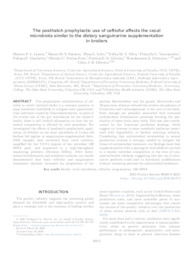The posthatch prophylactic use of ceftiofur affects the cecalmicrobiota similar to the dietary sanguinarine supplementation in broilers.
The posthatch prophylactic use of ceftiofur affects the cecalmicrobiota similar to the dietary sanguinarine supplementation in broilers.
Author(s): LEMOS, M. P. L.; SARAIVA, M. M. S.; LEITE, E. L.; SILVA, N. M. V.; VASCONCELOS, P. C.; GIACHETTO, P. F.; FREITAS NETO, O. C.; GIVISIEZ, P. E. N.; GEBREYES, W. A.; OLIVEIRA, C. J. B.
Summary: Abstract. The prophylactic administration of ceftiofur to newly hatched chicks is a common practice in some hatcheries worldwide to mitigate early gastrointestinal infections caused by Enterobacteriaceae. In spite of the crucial role of the gut microbiome for the broiler's health, there is still limited information on how the microbial composition is affected by such procedure. We investigated the effects of posthatch prophylactic application of ceftiofur on the cecal microbiota of 14-day-old broilers fed regular or sanguinarine-supplemented diets. DNA samples were extracted from cecal contents, amplified for the V3-V4 regions of the microbial 16S rRNA gene, and sequenced in a high-throughput sequencing platform (Illumina MiSeq). After downstream bioinformatics and statistical analyses, our results demonstrated that both ceftiofur and sanguinarine treatments similarly increased the proportions of the phylum Bacteroidetes and the genera Bacteroides and Megamonas, whereas reduced the relative abundances of Firmicutes and Lachnospiraceae in the ceca of the birds. Such changes are probably associated with increased carbohydrate fermentation processes favoring the production of short-chain fatty acids. This was also corroborated by the functional prediction findings, which suggest an increase in some metabolic pathways associated with digestibility in broilers receiving ceftiofur. Considering that antimicrobial stewardship in animal production systems is strongly needed to mitigate the threat of antimicrobial resistance, our findings show that supplementation with a phytogenic feed additive can lead to a similar microbial composition in the ceca of commercial broiler chickens, suggesting that the use of alternative products could lead to functional modifications without increasing pressure for antimicrobial resistance.
Publication year: 2020
Types of publication: Journal article
Observation
Some of Embrapa's publications are published as ePub files. To read them, use or download one of the following free software options to your computer or mobile device. Android: Google Play Books; IOS: iBooks; Windows and Linux: Calibre.
Access other publications
Access the Agricultural Research Database (BDPA) to consult Embrapa's full library collection and records.
Visit Embrapa Bookstore to purchase books and other publications sold by Embrapa.

